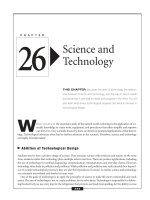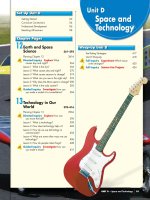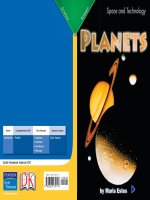4 17 earth and motion (space and technology)
Bạn đang xem bản rút gọn của tài liệu. Xem và tải ngay bản đầy đủ của tài liệu tại đây (2.74 MB, 10 trang )
Genre
Nonfiction
Comprehension Skill
Cause and Effect
Text Features
•
•
•
•
Captions
Labels
Diagrams
Glossary
Science Content
Earth Cycles
Scott Foresman Science 4.17
ISBN 0-328-13908-4
ì<(sk$m)=bdjai < +^-Ä-U-Ä-U
Vocabulary
axis
constellation
eclipse
ellipse
lunar eclipse
orbit
revolution
rotation
solar eclipse
What did you learn?
1. Why can’t you feel Earth moving as
it spins around its axis?
2. How do shadows change during the day?
3. If the Moon cannot produce its own light,
how are we able to see it?
4.
An eclipse
happens
by Christian
Downey
when one object comes between the Sun
and another object. Write to describe how
a lunar eclipse happens. Use details from
the book to support your answer.
5.
Picture Credits
Every effort has been made to secure permission and provide appropriate credit for photographic material.
The publisher deeply regrets any omission and pledges to correct errors called to its attention in subsequent editions.
Photo locators denoted as follows: Top (T), Center (C), Bottom (B), Left (L), Right (R), Background (Bkgd).
Illustration
10 Peter Bollinger.
Photographs
Opener: ©Sean Hunter/DK Images; 1 Getty Images; 2 (BR) Brand X Pictures, (BL) Getty Images; 4 Getty Images; 11 Larry
Landolfi /Photo Researchers, Inc.; 12 John Chumack /Photo Researchers, Inc.; 13 Getty Images; 14 David Nunuk /Photo
Researchers, Inc.
Unless otherwise acknowledged, all photographs are the copyright © of Dorling Kindersley, a division of Pearson.
ISBN: 0-328-13908-4
Copyright © Pearson Education, Inc. All Rights Reserved. Printed in the United States of America.
This publication is protected by Copyright, and permission should be obtained from the publisher prior to any
prohibited reproduction, storage in a retrieval system, or transmission in any form by any means, electronic,
mechanical, photocopying, recording, or likewise. For information regarding permission(s), write to
Permissions Department, Scott Foresman, 1900 East Lake Avenue, Glenview, Illinois 60025.
3 4 5 6 7 8 9 10 V010 13 12 11 10 09 08 07 06 05
Cause and Effect What effect does
Earth’s tilted axis have on weather in the
Northern and Southern Hemispheres?
How Earth Moves
Earth is always moving. In fact, Earth is spinning as
you read this. Why can’t you feel it? You are moving
with Earth. When Earth spins, everything on it spins
too. Earth’s movement is smooth and steady.
How do you know Earth is moving? One way
you can tell is that the Sun and the stars seem to
be moving in the sky. Another way is by observing the
change in seasons. This change is more obvious in some
places than in others. The change in seasons is partly
due to how Earth moves through space.
Scientists use many types of equipment to see how
objects seem to move in the sky.
Earth as seen from space
2
The Rotation of Earth
Earth spins around its axis. The axis
is an imaginary line that goes through
Earth from the North Pole to the South
Pole. A rotation is the spinning of Earth
around its axis. One complete turn
around the axis is one rotation. It takes
Earth almost twenty-four hours, or one
day, to make a full rotation.
Earth spins from west to east,
but objects in the sky appear to move
from east to west. You can see why this
happens with a simple experiment. Hold
your hand in front of your face. Move
your head to the right. Did you notice
that your hand seemed to move to the left?
This is how the movement of the Sun and
other stars appears to people on Earth.
Earth moves from west to east, and the
Sun and other stars appear to move from
east to west.
The Sun appears to move
through the sky during the day.
3
Shadows
In the morning and evening, when the Sun seems low
in the sky, shadows look long. In the middle of the day,
when the Sun appears to be overhead, shadows look
short. Earth’s rotation also causes day to become night
and night to become day. Any place that is turned
toward the Sun experiences daytime. Nighttime is when
that part of Earth is turned away from the Sun.
The Sun shines too brightly for us to see stars
during the day. Look at a clear sky for several nights.
You may notice that stars seem to move from east to
west in the sky.
Daylight
Every place on Earth has a different number of
daylight hours at different times of the year. This chart
shows the changes in daylight hours over a year, in
Chicago, a city in the Northern Hemisphere.
Hours of Daylight in Chicago
14.6
15
10
12.5
9.5
9.2
5
0
4
January
May
September
December
5
Revolutions of Earth
The orbit of Earth is an ellipse. An ellipse is a
sort of stretched-out, flattened circle. Earth’s distance
from the Sun changes at different parts of its orbit.
Sometimes Earth is farther from the Sun than at other
times. Sometimes it is close.
Gravity pulls two objects together. It can work
from far away. Gravity is the force that keeps Earth
revolving around the Sun. Earth would move out into
space if gravity did not keep it in place. Gravity would
cause Earth and the Sun to crash into each other if
Earth stopped moving.
Earth rotates on its axis. It also revolves around the
Sun at the same time. A revolution is the movement of
one object around another. Earth has made one
revolution when it has made one full trip around the
Sun. An orbit is the path Earth takes around the Sun.
Earth completes one full revolution around the Sun
in about 365 days, or one year. Earth travels a long
distance at a fast speed during that time! Earth travels a
total of about 940,000,000 kilometers in a year. It moves
at a speed of about 107,000 kilometers per hour.
The sizes and distances in this
diagram are not true to scale.
Uranus
Neptune
Venus
the Sun
Mercury
Jupiter
Mars
Earth
Saturn
Pluto
6
Earth and the other
planets of the solar
system travel around
the Sun in their orbits.
7
Earth’s Axis
Earth’s axis is always tilted in the same direction.
This tilt means that different areas on Earth get direct
sunlight at different places in the orbit.
Earth can be divided into two halves, the Northern
and Southern Hemispheres. When one hemisphere is
tilted toward the Sun, the other is tilted away. The
hemisphere that is tilted toward the Sun has warmer
weather and longer days. It is summer there. While that
half of Earth is warm, the other half is colder. It is
winter in the other hemisphere. Earth’s axis is not tilted
toward or away from the Sun during spring or fall.
During spring and fall in both hemispheres, the weather
is less extreme. Hours of daylight and nighttime are
more balanced.
Different hemispheres tilt toward the Sun at
different points in Earth’s orbit.
8
When it is winter in the
United States…
…it is summer in Australia.
The Southern Hemisphere is tilted toward the Sun
during part of the year. It gets more direct sunlight. That
means it gets more heat. Temperatures there are higher,
and it is summer. While the Southern Hemisphere is
tilted toward the Sun, the Northern Hemisphere is tilted
away from the Sun. It gets less direct sunlight. So it gets
less heat and has lower temperatures. It is winter. That
means that while it is winter in the United States, it is
summer in Australia! Temperatures in the spring and fall
are milder in both hemispheres.
9
Patterns in the Sky
The Moon is the easiest object to see in the night sky.
The Moon appears to shine brightly. But the Moon’s
light comes from sunlight reflecting off its surface. The
Sun acts as a light bulb, and the Moon acts as a mirror.
The Moon orbits Earth. The Moon’s orbit, just like
Earth’s orbit, is an ellipse. There is gravity between the
Moon and Earth. This holds the Moon in its orbit.
The Moon’s revolution around Earth takes a little
longer than twenty-seven days.
The Moon turns around its own axis as it circles
Earth. As it rotates one time on its axis, it also revolves
one time around Earth. Because of this, the same side
of the Moon always faces Earth.
light from
the Sun
The Moon spins around on its axis as it revolves around Earth.
10
The Moon’s Phases
The Moon appears to be different
shapes at different times of the
month. Only half of the Moon ever
faces the Sun. Sunlight reflects on the
surface of that half. A full Moon
appears when the lighted half faces
Earth directly.
Most of the time, we see only
part of the lighted half of the Moon.
The different shapes that the Moon
seems to have are called phases of the
Moon. Each phase lasts a short time.
A set of phases begins with a new
Moon. This is when the part of the
Moon facing Earth cannot be seen. It
is followed by a crescent. This is a
sliver of lighted Moon. Then a larger
part of the Moon is visible. We call
this the first quarter. Soon the entire
half of the Moon is visible. This full
Moon appears as a full circle. After
that we see the Moon in the phase
called the last quarter. It looks similar
to a half circle. The phases begin
again with the new Moon.
crescent Moon
first quarter Moon
full Moon
last quarter Moon
11
Eclipses
An eclipse happens when one object in space comes
between the Sun and another object and casts its
shadow on the other object. This happens when the
Moon crosses Earth’s shadow, or when the Moon’s
shadow reaches part of Earth.
A lunar eclipse occurs when the Moon passes
directly through Earth’s shadow. This can only happen
when the Moon is full. The Moon and the Sun must
also be on opposite sides of Earth for this to happen.
During a lunar eclipse, Earth blocks all or part of the
Sun’s rays from reaching the Moon.
A partial eclipse happens when only part of the
Moon is in Earth’s shadow. Not every place on Earth
can see every eclipse. A lunar eclipse is only visible
from the places on Earth where it is night.
sunlight
lunar eclipse
12
During a solar eclipse, the Moon blocks
the Sun from view.
A solar eclipse occurs when the Moon passes
between the Sun and Earth and casts its shadow
on Earth. The Moon may block part or all of the Sun
from view. When the Moon blocks the Sun, a shadow is
cast. But the shadow covers only a small part of Earth.
A solar eclipse can only be seen from the places on
Earth that are in Moon’s shadow.
A solar eclipse is an amazing sight. However, it
is never safe to look straight at the Sun. Any direct
sunlight can damage your eyes, even causing blindness.
13
Stars
Constellations
Scientists think there may be 1 billion trillion stars in
the universe. That would be a 1 followed by 21 zeroes!
That’s a lot of stars! The Sun is the star closest to Earth.
It gives Earth light and energy. Some stars are bigger and
hotter than the Sun. Other stars are smaller and cooler.
The brightness of the Sun keeps us from seeing stars
during the day. If stars are very far away, they may not
seem as bright. You can see more stars with a telescope
than you can with just your eyes.
Some stars seem to form
patterns. Scientists call each
of these star patterns a
constellation. Astronomers
have divided the sky into
eighty-eight constellations.
Stars are often identified
by the constellations they
are in. Although stars may
appear close together within
a constellation, they may
be very far apart.
The constellation
Because of Earth’s rotation,
Scorpio forms the
stars appear to move through the shape of a scorpion.
sky in a straight line at the equator. Near the North
and South Poles, stars appear to move in circles.
The stars that can be seen in the Northern Hemisphere
are different from the stars seen in the Southern
Hemisphere. Polaris, or the North Star, is visible
in the sky over the North Pole.
Eclipses and constellations make our sky fun to
watch and learn about. Scientists continue to learn
new things about Earth, the Sun, and the Moon. Years
from now, people on Earth will look at the same sky but
may know much more about it than we do now.
14
15
Vocabulary
Glossary
axis
constellation
eclipse
axis
ellipse
lunar eclipse
orbit
constellation
revolution
rotation
solar eclipse
eclipse
an imaginary line that goes through
Earth’s center
a group of stars in the sky that seem to
form a pattern
the passing of an object in space
between the Sun and another object
ellipse
a stretched-out, flattened circle
lunar eclipse
the passing of the Moon directly
through Earth’s shadow
orbit
the path Earth follows as it revolves
around the Sun
Picture Credits
Every effort has been made to secure permission and provide appropriate credit for photographic material.
The publisher deeply regrets any omission and pledges to correct errors called to its attention in subsequent editions.
revolution
the movement of one object around
Photo locators denoted as follows: Top (T), Center (C), Bottom (B), Left (L), Right (R), Background (Bkgd).
another
Illustration
10 Peter Bollinger.
Photographs
Opener: ©Sean Hunter/DK Images; 1 Getty Images; 2 (BR) Brand X Pictures, (BL) Getty Images; 4 Getty Images; 11 Larry
rotation
the spinning of Earth around
Landolfi /Photo Researchers, Inc.; 12 John Chumack /Photo Researchers, Inc.; 13 Getty Images; 14 David Nunuk /Photo
Researchers, Inc.
its axis
Unless otherwise acknowledged, all photographs are the copyright © of Dorling Kindersley, a division of Pearson.
ISBN: 0-328-13908-4
solar
eclipse
the passing of the Moon between the
Copyright © Pearson Education, Inc. All Rights Reserved. Printed in the United States of America.
This publication is protected by Copyright,
and permission
should be obtained from the publisher prior to any
Sun and
Earth
prohibited reproduction, storage in a retrieval system, or transmission in any form by any means, electronic,
mechanical, photocopying, recording, or likewise. For information regarding permission(s), write to
Permissions Department, Scott Foresman, 1900 East Lake Avenue, Glenview, Illinois 60025.
3 4 5 6 7 8 9 10 V010 13 12 11 10 09 08 07 06 05
16
What did you learn?
1. Why can’t you feel Earth moving as
it spins around its axis?
2. How do shadows change during the day?
3. If the Moon cannot produce its own light,
how are we able to see it?
4.
An eclipse happens
when one object comes between the Sun
and another object. Write to describe how
a lunar eclipse happens. Use details from
the book to support your answer.
5.
Cause and Effect What effect does
Earth’s tilted axis have on weather in the
Northern and Southern Hemispheres?









